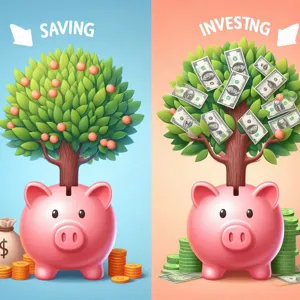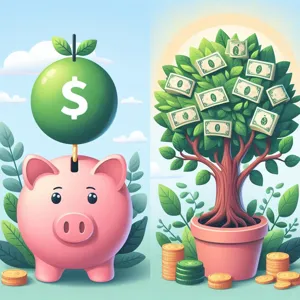When it comes to building financial security and growing your wealth, understanding the difference between saving and investing is essential.
While both strategies play important roles in managing your money, they serve distinct purposes and come with varying levels of risk and potential reward. Saving typically involves setting aside money in safe, easily accessible accounts for short-term goals or emergencies, whereas investing focuses on putting your money to work over the long term with the aim of generating higher returns. In this blog post, we’ll explore the key differences between saving and investing, helping you make informed decisions that align with your financial goals and pave the way to a prosperous future.
1. Introduction: Why Understanding Saving and Investing Matters

When it comes to building your financial future, understanding the difference between saving and investing is crucial. While both strategies play important roles in managing your money, they serve distinct purposes and come with different levels of risk and potential reward. Saving typically involves setting aside money in safe, easily accessible accounts to cover short-term needs or emergencies. Investing, on the other hand, is about putting your money to work over the long term to grow your wealth through assets like stocks, bonds, or real estate. By grasping the key differences between saving and investing, you can make informed decisions that align with your financial goals, whether it’s building an emergency fund, planning for retirement, or funding a major purchase. This foundational knowledge empowers you to create a balanced approach that helps your money work smarter for you.
2. What is Saving?
Saving is the practice of setting aside a portion of your income for future use, typically in a safe and easily accessible place. It’s about preserving your money and building a financial cushion that can cover emergencies, short-term goals, or unexpected expenses. Common savings vehicles include traditional savings accounts, money market accounts, or even cash kept in a secure location. The primary goal of saving is capital preservation, meaning you want to keep your money safe without risking loss, even if that means earning minimal or no interest. While saving is essential for financial stability and peace of mind, it generally does not offer significant growth potential compared to investing. Understanding saving as a foundational step will help you manage your finances wisely before moving on to more growth-oriented strategies like investing.
3. What is Investing?

Investing is the process of allocating your money into assets or ventures with the expectation of generating a profitable return over time. Unlike saving, which typically involves setting aside money in low-risk, easily accessible accounts, investing involves taking calculated risks in order to achieve higher potential growth. Common investment vehicles include stocks, bonds, mutual funds, real estate, and even starting or funding a business.
The primary goal of investing is to grow your wealth by earning income through dividends, interest, or capital appreciation. While investing carries the possibility of loss, it also offers opportunities to outpace inflation and build substantial financial security for the future. Successful investing requires research, patience, and a clear understanding of your financial goals and risk tolerance. By making informed investment choices, you can put your money to work and create a path toward long-term financial growth.
4. Key Differences Between Saving and Investing
Understanding the key differences between saving and investing is crucial for effectively growing your wealth. At its core, saving involves setting aside money in a secure and easily accessible place, such as a savings account or a money market fund. The primary goal of saving is to preserve your capital and maintain liquidity, making it ideal for short-term goals or emergency funds. Savings typically offer lower returns but come with minimal risk, ensuring your money is safe and readily available when you need it.
Investing, on the other hand, involves putting your money into assets like stocks, bonds, mutual funds, or real estate with the expectation of generating higher returns over time. While investing carries a higher level of risk—including the potential for loss—historical data shows that it also has the potential for greater rewards, especially over the long term. Investments are better suited for achieving long-term financial goals, such as retirement or building wealth, as they benefit from compounding growth and market appreciation.
In summary, saving prioritizes safety and liquidity with modest returns, making it ideal for short-term needs, while investing focuses on growth and income generation, accepting higher risks for potentially higher rewards. Striking the right balance between the two is key to a well-rounded financial strategy that supports both your immediate needs and future aspirations.
5. Risk Levels: Saving vs. Investing

When it comes to growing your wealth, understanding the difference in risk levels between saving and investing is crucial. Saving typically involves putting your money into low-risk, easily accessible accounts such as savings accounts, money market accounts, or certificates of deposit (CDs). These options offer stability and security, ensuring that your principal amount is protected. However, the trade-off is that the returns are generally modest and may barely keep up with inflation.
On the other hand, investing involves allocating your money into assets like stocks, bonds, mutual funds, or real estate, which come with varying degrees of risk. While investing carries the potential for higher returns, it also means your investments can fluctuate in value, and there’s a possibility of losing some or all of your initial capital. The key is to assess your risk tolerance, financial goals, and time horizon before deciding how much of your money to save versus invest. By balancing safer savings with carefully chosen investments, you can build a diversified approach that aims to grow your wealth while managing risk effectively.
6. Potential Returns: Comparing Savings Accounts and Investments
When it comes to growing your wealth, understanding the potential returns of savings accounts versus investments is crucial. Savings accounts typically offer a fixed, low-interest rate, providing a safe and predictable way to store your money. While this ensures your principal is secure and easily accessible, the returns are often modest and may barely keep pace with inflation.
Investments, on the other hand, come with a wider range of potential returns. Whether you choose stocks, bonds, mutual funds, or real estate, investments have the potential to generate significantly higher returns over time. However, this opportunity for growth comes with increased risk and market volatility. Unlike savings accounts, the value of investments can fluctuate, and there is a chance you could lose some or all of your initial capital.
Ultimately, the choice between saving and investing depends on your financial goals, risk tolerance, and time horizon. While savings accounts are ideal for short-term goals and emergency funds, investments are better suited for long-term wealth growth. By understanding these differences, you can make informed decisions that align with your financial objectives and help you build a stronger financial future.
7. Liquidity and Accessibility of Funds

When it comes to managing your money, understanding the liquidity and accessibility of your funds is crucial. Liquidity refers to how quickly and easily you can convert your assets into cash without significantly affecting their value. Savings accounts typically offer high liquidity, allowing you to access your money almost instantly whenever you need it. This makes savings ideal for emergency funds or short-term financial goals where having quick access to cash is essential.
On the other hand, investments such as stocks, bonds, or real estate often come with lower liquidity. While these assets have the potential for higher returns over time, converting them into cash can take days, weeks, or even months, depending on the investment type and market conditions. Additionally, selling investments prematurely may result in losses or penalties, reducing your overall returns.
Therefore, when deciding between saving and investing, consider your financial needs and timeline. If you require immediate or short-term access to your funds, saving is the safer option. However, if you’re aiming for long-term growth and can afford to lock away your money for a period, investing can help build your wealth more effectively. Balancing both strategies allows you to maintain liquidity for emergencies while maximizing growth potential through investments.
8. Time Horizon: When to Save and When to Invest
Understanding your time horizon is crucial when deciding whether to save or invest your money. Your time horizon refers to the length of time you plan to hold your money before you need to access it. This factor plays a significant role in determining the best strategy to grow your wealth effectively and safely.
If you have a short-term goal—such as buying a car, going on a vacation, or building an emergency fund within the next few months to a couple of years—saving is generally the better option. Savings accounts, money market accounts, or certificates of deposit (CDs) provide liquidity and security, ensuring your funds are easily accessible when needed without the risk of market fluctuations.
On the other hand, if your time horizon is long-term, like saving for retirement, your child’s college education, or purchasing a home several years down the road, investing becomes more advantageous. Investing in stocks, bonds, mutual funds, or ETFs offers the potential for higher returns, which can outpace inflation and grow your wealth substantially over time. However, it’s important to remember that investments come with risks and short-term volatility, so having a longer time horizon allows you to ride out market ups and downs.
By aligning your financial goals with your time horizon, you can make informed decisions about when to save and when to invest, setting yourself up for greater financial success in the future.
9. Common Saving Vehicles
When it comes to growing your wealth, understanding the different saving vehicles available can help you choose the best option to meet your financial goals. Saving vehicles are financial products designed to help you set aside money safely while earning some interest or returns, typically with low risk. Here are some of the most common saving vehicles you should know about:
**1. Savings Accounts:**
Savings accounts are one of the simplest and most accessible saving vehicles. Offered by banks and credit unions, they allow you to deposit money and earn interest over time. While the interest rates tend to be relatively low, your funds remain liquid and easily accessible, making savings accounts ideal for an emergency fund or short-term savings goals.
**2. Certificates of Deposit (CDs):**
CDs are time-bound deposits where you agree to keep your money locked in for a fixed term, ranging from a few months to several years. In return, banks typically offer higher interest rates than regular savings accounts. However, withdrawing funds before the maturity date usually incurs penalties. CDs are suitable for savers who want a guaranteed return and don’t need immediate access to their money.
**3. Money Market Accounts:**
Money market accounts blend features of savings and checking accounts. They usually offer higher interest rates than traditional savings accounts and may come with limited check-writing privileges. These accounts are a good option if you want to earn more interest but still want some flexibility in accessing your funds.
**4. Treasury Securities:**
Government-issued securities, such as Treasury bills, notes, and bonds, are considered very safe saving vehicles. They provide fixed interest payments and return your principal at maturity. While these investments are low-risk, the returns are generally modest, making them suitable for conservative savers.
Each of these saving vehicles serves a different purpose depending on your time horizon, risk tolerance, and liquidity needs. Understanding these options empowers you to make informed decisions, ensuring your savings work effectively toward building your financial security.
10. Popular Investment Options
When it comes to growing your wealth, understanding the various investment options available is crucial. Each option comes with its own set of risks, potential returns, and time horizons, making it important to choose the ones that align with your financial goals and risk tolerance. Here are some of the most popular investment options to consider:
**Stocks:** Investing in individual company stocks allows you to own a share of that business. Stocks have the potential for high returns but can be volatile in the short term. They are ideal for investors with a longer time horizon who can weather market fluctuations.
**Bonds:** Bonds are essentially loans you give to governments or corporations in exchange for regular interest payments. They tend to be more stable than stocks and provide steady income, making them a popular choice for conservative investors or those seeking diversification.
**Mutual Funds and ETFs:** These funds pool money from multiple investors to purchase a diversified portfolio of stocks, bonds, or other assets. They offer diversification and professional management, making them accessible options for beginners.
**Real Estate:** Investing in property can provide rental income as well as potential appreciation over time. While it requires more capital and active management, real estate can be a valuable addition to a diversified portfolio.
**Retirement Accounts:** Options like 401(k)s and IRAs offer tax advantages that can help your investments grow more efficiently. Contributing to these accounts is often a smart move for long-term wealth building.
**Cryptocurrency:** A newer and highly volatile asset class, cryptocurrencies like Bitcoin and Ethereum have attracted attention for their growth potential. However, due to their unpredictability, they should be approached with caution and only form a small portion of a diversified portfolio.
Choosing the right mix of these investment options depends on your individual goals, timeline, and comfort with risk. By educating yourself and possibly consulting with a financial advisor, you can create a strategy that effectively grows your wealth over time.
11. How Inflation Impacts Saving and Investing
Inflation is the rate at which the general level of prices for goods and services rises, eroding purchasing power over time. When it comes to saving and investing, understanding how inflation impacts each is crucial for making informed decisions about growing your wealth.
With traditional savings accounts, the interest rates often struggle to keep pace with inflation. This means that while your money may be safe and easily accessible, its real value could actually decrease over time. For example, if your savings account offers a 2% interest rate but inflation is running at 3%, your purchasing power effectively shrinks by 1% each year.
Investing, on the other hand, offers the potential to outpace inflation by generating higher returns through assets like stocks, bonds, or real estate. While investing carries more risk and market fluctuations, it provides an opportunity to grow your wealth in a way that preserves and increases your purchasing power over the long term.
Understanding the impact of inflation helps you balance your approach: keeping enough in savings for emergencies and short-term needs, while investing strategically to build wealth and combat the eroding effects of inflation over time. This balance is key to maintaining and growing your financial health in an ever-changing economic landscape.
12. Setting Financial Goals: Saving vs. Investing Strategies
Setting clear financial goals is an essential step in determining whether saving or investing is the right strategy for you. While both approaches aim to grow your wealth, they serve different purposes and timelines. Saving is typically geared towards short-term goals or emergency funds—think of buying a new appliance, going on a vacation, or building a safety net to cover unexpected expenses. It offers low risk and high liquidity, meaning you can access your money easily when needed. On the other hand, investing is better suited for long-term objectives such as retirement, purchasing a home, or funding education. Investing involves putting your money into assets like stocks, bonds, or mutual funds, which carry a higher risk but also the potential for greater returns over time. When setting your financial goals, consider factors such as your time horizon, risk tolerance, and the amount of capital you’re comfortable allocating. By clearly defining your goals—whether it’s preserving capital in a savings account or seeking growth through investments—you can create a personalized strategy that aligns with your financial aspirations and helps maximize your wealth-building potential.
13. Building an Emergency Fund Before Investing
Before diving into the world of investing, it’s crucial to establish a solid financial safety net by building an emergency fund. An emergency fund is a dedicated stash of money set aside to cover unexpected expenses such as medical emergencies, car repairs, or sudden job loss. Having this fund in place provides peace of mind and financial stability, allowing you to handle unforeseen situations without derailing your long-term investment goals.
Experts typically recommend saving three to six months’ worth of living expenses in an easily accessible account, like a high-yield savings account. This ensures you have quick access to cash when needed, without the risk of market fluctuations affecting your funds. By prioritizing an emergency fund first, you avoid the temptation to dip into your investments prematurely, which could lead to losses or missed growth opportunities.
In essence, building an emergency fund lays the groundwork for a more confident and disciplined investing journey. It safeguards your financial health and empowers you to make investment decisions with a clear mind, knowing that your immediate needs are fully covered.
14. Tips for Balancing Saving and Investing
Finding the right balance between saving and investing is crucial for building and preserving your wealth over time. While saving provides a safety net and liquidity for short-term needs, investing offers the potential for higher returns and long-term growth. Here are some practical tips to help you strike that balance effectively:
First, establish an emergency fund by saving three to six months’ worth of living expenses in a high-yield savings account. This ensures you have quick access to cash for unexpected situations without having to dip into your investments.
Next, define your financial goals clearly—whether it’s buying a home, retiring comfortably, or funding education. Short-term goals (within 1-3 years) are better suited to saving, while longer-term objectives (5+ years) can benefit from investing in diversified assets like stocks, bonds, or mutual funds.
Regularly review your budget to allocate a consistent portion of your income to both saving and investing. Automating these contributions can help maintain discipline and growth over time.
Additionally, consider your risk tolerance and time horizon carefully before deciding how much to invest versus save. Younger investors with a longer time frame can generally take on more investment risk, while those nearing retirement might prioritize safer, more liquid savings.
Lastly, stay informed and be patient. Wealth-building is a marathon, not a sprint. By thoughtfully balancing saving and investing, you position yourself to meet immediate needs while also growing your financial future securely.
15. Conclusion: Making Smart Choices to Grow Your Wealth
In conclusion, understanding the key differences between saving and investing is crucial for making smart financial decisions that align with your goals. Saving offers security and easy access to your funds, making it ideal for short-term needs and emergency cushions. On the other hand, investing provides the potential for higher returns over time, helping you build wealth and achieve long-term objectives such as retirement, buying a home, or funding education.
By striking the right balance between saving and investing, you can create a personalized strategy that safeguards your financial stability while positioning you for growth. Remember, the journey to growing your wealth is not about choosing one over the other but about knowing when and how to use each tool effectively. Educate yourself, stay consistent, and remain patient—these smart choices will empower you to build a secure and prosperous financial future.
Understanding the key differences between saving and investing is essential for anyone looking to build and grow their wealth effectively. While saving offers security and easy access to your funds, investing provides the potential for higher returns and long-term financial growth. By striking the right balance between the two based on your goals, risk tolerance, and timeline, you can create a personalized strategy that safeguards your future while maximizing opportunities. Remember, financial success doesn’t happen overnight, but with informed decisions and consistent effort, you can pave the way to a more prosperous and secure tomorrow. Start taking control of your financial journey today, and watch your wealth flourish over time.






